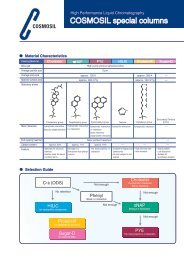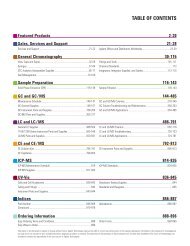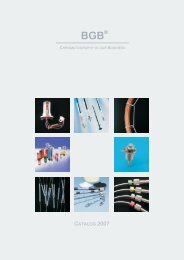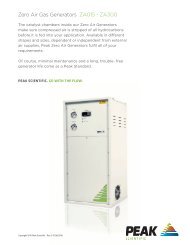Analysis of Carbaryl and Carbofuran in Drinking ... - BGB Analytik AG
Analysis of Carbaryl and Carbofuran in Drinking ... - BGB Analytik AG
Analysis of Carbaryl and Carbofuran in Drinking ... - BGB Analytik AG
Create successful ePaper yourself
Turn your PDF publications into a flip-book with our unique Google optimized e-Paper software.
Introduction<br />
<strong>Carbaryl</strong> <strong>and</strong> carb<strong>of</strong>uran are N-methyl carbamate pesticides<br />
(structure shown <strong>in</strong> Figure 1), which are classified as broadspectrum<br />
<strong>in</strong>secticides <strong>and</strong> are mostly used on rice <strong>and</strong> corn<br />
crops. Excess pesticide can contam<strong>in</strong>ate ground water, surface<br />
water, <strong>and</strong> dr<strong>in</strong>k<strong>in</strong>g water. Because this k<strong>in</strong>d <strong>of</strong> pesticide<br />
has been shown to create health problems with blood <strong>and</strong><br />
with the nervous <strong>and</strong> reproductive systems, actions have<br />
been taken to control these compounds <strong>and</strong> require that their<br />
amounts be measured <strong>in</strong> dr<strong>in</strong>k<strong>in</strong>g water.<br />
Regulatory methods are set <strong>in</strong> many countries. The Ch<strong>in</strong>a<br />
dr<strong>in</strong>k<strong>in</strong>g water st<strong>and</strong>ards published <strong>in</strong> 2006 restrict the maximum<br />
limit <strong>of</strong> carb<strong>of</strong>uran <strong>in</strong> dr<strong>in</strong>k<strong>in</strong>g water to 7 ppb <strong>and</strong> use<br />
liquid-liquid extraction to test the water samples. The U.S.<br />
Environmental Protection Agency (EPA) Method 531.1 sets<br />
the maximum contam<strong>in</strong>ation level (MCL) at 40 ppb <strong>and</strong> uses<br />
direct aqueous <strong>in</strong>jection [1]. Each method has its own disadvantages.<br />
Liquid-liquid extraction is laborious, time-consum<strong>in</strong>g<br />
work that requires a large amount <strong>of</strong> organic solvents.<br />
Direct aqueous <strong>in</strong>jection is a simple method with less <strong>in</strong>terferential<br />
peaks; however, it is not suitable for measur<strong>in</strong>g<br />
lower levels <strong>of</strong> compounds <strong>in</strong> dr<strong>in</strong>k<strong>in</strong>g water.<br />
Solid-phase extraction (SPE) is <strong>of</strong>ten used for the enrichment<br />
<strong>of</strong> water samples. This process is typically done us<strong>in</strong>g a st<strong>and</strong>ard<br />
SPE vacuum manifold but can be easily automated for<br />
the enhanced sensitivity required to measure low-level<br />
organic compounds <strong>in</strong> dr<strong>in</strong>k<strong>in</strong>g water.<br />
This application note describes an improved method for determ<strong>in</strong><strong>in</strong>g<br />
low levels <strong>of</strong> carbaryl <strong>and</strong> carb<strong>of</strong>uran <strong>in</strong> dr<strong>in</strong>k<strong>in</strong>g water.<br />
The method applies an automated procedure <strong>of</strong> sample concentration<br />
<strong>and</strong> post-column derivatization to successfully<br />
measure carbaryl <strong>and</strong> carb<strong>of</strong>uran <strong>in</strong> dr<strong>in</strong>k<strong>in</strong>g water at the ppt<br />
level. New Agilent SampliQ C18 SPE cartridges were used for<br />
sample enrichment from water. The sample was then analyzed<br />
with Agilent TC-C18(2) columns, which provide symmetrical<br />
peak shape <strong>and</strong> high sensitivity. Last, the separated compounds<br />
were derivatizated before detection with a fluorescence<br />
detector. The derivatization reaction is shown <strong>in</strong><br />
Figure 2. <strong>Carbaryl</strong> <strong>and</strong> carb<strong>of</strong>uran are first hydrolyzed under<br />
basic conditions at high temperature <strong>in</strong>to methylam<strong>in</strong>e <strong>and</strong><br />
then react with o-phthalaldehyde (OPA) <strong>and</strong> 2-mercaptoethanol<br />
<strong>in</strong>to iso<strong>in</strong>dole, which has strong fluorescence. This is a simple,<br />
automated, fast, <strong>and</strong> high recovery method that is fit for<br />
quality control <strong>of</strong> dr<strong>in</strong>k<strong>in</strong>g water.<br />
2<br />
O<br />
O<br />
N H<br />
Experimental<br />
Instruments<br />
O<br />
HN<br />
O O<br />
<strong>Carbaryl</strong> Carb<strong>of</strong>uran<br />
Figure 1. Structures <strong>of</strong> carbaryl <strong>and</strong> carb<strong>of</strong>uran.<br />
O<br />
<strong>Carbaryl</strong><br />
O<br />
O<br />
HN<br />
N H<br />
O O<br />
Carb<strong>of</strong>uran<br />
Nonfluorescent<br />
OH _<br />
95 °C<br />
CH 3 NH<br />
2<br />
+ RSH <strong>and</strong><br />
Room temperature<br />
Figure 2. Derivatization reaction <strong>of</strong> carbaryl <strong>and</strong> carb<strong>of</strong>uran.<br />
O<br />
O<br />
H<br />
H<br />
SR<br />
N<br />
Strong<br />
fluorescent<br />
HPLC Conditions<br />
Instrument Agilent 1100 or 1200 with fluorescence<br />
detector (FLD): A multidraw upgrade kit<br />
(p/n G1313-68711) can be <strong>in</strong>stalled when<br />
400-µL <strong>in</strong>jections are needed.<br />
Column Agilent TC-C18(2) 4.6 × 150 mm, 5 µm<br />
(p/n 588935-902)<br />
Mobile phase A: Water, B: Methanol<br />
0 m<strong>in</strong> 42% B, 5 m<strong>in</strong> 55% B, 12 m<strong>in</strong> 60% B,<br />
13 m<strong>in</strong> 42% B, stop time 15 m<strong>in</strong>, post-run 2 m<strong>in</strong><br />
Flow rate 1.0 mL/m<strong>in</strong><br />
Column temperature 30 °C<br />
FLD detector Ex 339 nm; Em 445 nm<br />
Injection volume 10 µL<br />
P<strong>in</strong>nacle PCX Picker<strong>in</strong>g Laboratories, Inc.<br />
derivatization <strong>in</strong>strument<br />
Post-Column Reaction Conditions<br />
Flow rate <strong>of</strong> reagents 0.1 mL/m<strong>in</strong><br />
Reactor temperature 95 °C<br />
Derivatization temperature Room temperature<br />
Caliper LS Autotrace SPE Caliper Life Sciences, Inc.<br />
Workstation<br />
SPE Cartridges Agilent SampliQ C18, 6ml/500mg (p/n 5982-1165)<br />
Technologies, Inc.<br />
TurboVap II Evaporation Caliper Life Sciences, Inc.<br />
System






